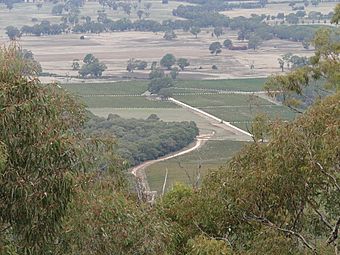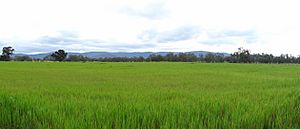Pyrenees (Victoria) facts for kids
| Wine region | |

Vineyards near Avoca, viewed from the Pyrenees ranges
|
|
| Type | Australian geographical indication |
|---|---|
| Year established | 2000 |
| Years of wine industry | 1848–present |
| Country | Australia |
| Part of | Western Victoria |
The Pyrenees is a special area in Victoria, Australia. It's known for its beautiful mountains, called the Pyrenees ranges, and for making delicious wine. The main town in this area is Avoca.
The Pyrenees mountains are part of Australia's huge Great Dividing Range. These mountains are between 300 and 750 meters (about 980 to 2,460 feet) high. Some of the tallest peaks are Mount Avoca (747 m) and Mount Warrenmang (537 m).
Contents
Discovering the Pyrenees
The first European to explore this area was Thomas Mitchell. He was an explorer and surveyor. He traveled through the Pyrenees region in 1836.
The mountains reminded him of the Pyrenees in Europe. He had served there as an army officer. That's why he gave them the name "Pyrenees." Mitchell found the climate here was milder. It also had more water than other parts of New South Wales. He called the area "Australia Felix" (meaning "Lucky Australia"). He encouraged people to settle there.
The Story of Pyrenees Wine
Early Vineyards (1858-1960s)
People first planted grapevines in the Pyrenees in 1858. Several winemakers grew grapes and sold wine in the late 1800s. This continued into the early 1900s.
One of the first winemakers was Edwin Horatio Mackereth. His family sold his vineyard to a dairy farmer in 1929. Another early producer, Kofoeds, made wine until 1947.
Wine Returns (1960s Onwards)
In the 1960s, winemaking started again in the area. Nathan & Wyeth teamed up with a French company, Rémy Martin. They planted new grapes in 1963. Important government officials attended the planting ceremony.
Since the 1970s, the Pyrenees has become famous. It produces rich, full-bodied red wines. These wines are mostly made from Shiraz and Cabernet Sauvignon grapes.
Growing Number of Wineries
In the 1970s and 1980s, there were eight main wineries. These included Chateau Rémy (now Blue Pyrenees Estate) and Mount Avoca Vineyard. Other well-known names were Dalwhinnie Vineyard and Taltarni Vineyards.
Today, there are almost 30 wineries in the region. Many new vineyards were planted in the 1990s. The first vineyards were near Moonambel and Avoca. Later, large vineyards were planted in the Landsborough valley. Now, vineyards stretch from Waubra to St Arnaud.
Types of Grapes Grown
The main white grapes grown are Sauvignon blanc, Chardonnay, and Viognier. Smaller amounts of Semillon and Pinot Grigio are also grown.
For red wines, Shiraz and Cabernet Sauvignon are the most important. But many other types of grapes are also grown. These include Merlot, Cabernet Franc, and Grenache from France. Italian grapes like Sangiovese, Nebbiolo, and Lagrein are also grown. From Spain, you can find Tempranillo.
Tourism and Exports
Tourism is very important for the Pyrenees region. Many wineries offer "cellar-door" tastings. This means you can try the wines right where they are made. Some wineries also offer places to stay and eat. The region is always adding new things for visitors.
Many wineries also sell their wines to other countries. They export to places like China, the US, and Scandinavia.
See also
 In Spanish: Pirineos (Victoria) para niños
In Spanish: Pirineos (Victoria) para niños


